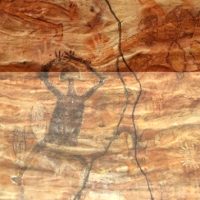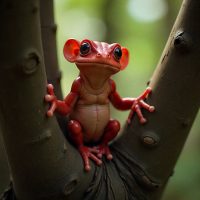Yara-ma-yha-who : The Vampire Spirit of Koori Mythology
Listen
At a glance
| Description | |
|---|---|
| Origin | Koori Mythology |
| Classification | Spirits |
| Family Members | N/A |
| Region | Australia |
| Associated With | Blood sucking |
Yara-ma-yha-who
Introduction
The Yara-ma-yha-who is one of the most distinctive beings in Koori mythology, originating from the Indigenous cultures of southeastern Australia. Far removed from majestic creator spirits or heroic ancestors, this creature occupies a more unsettling and cautionary place in storytelling. It is said to live in towering fig trees, waiting silently for those who wander too close. Through generations, its legend has served both as a warning to children exploring the bush and as a reminder of the spiritual dangers believed to inhabit the natural landscape. The Yara-ma-yha-who’s tale stands out for its blend of horror, humour, and transformation, reflecting deeper cultural lessons about respect for the land and the unseen forces within it.
Physical Traits
The Yara-ma-yha-who is traditionally described as a small red humanoid with a frog-like quality that sets it apart from other mythic predators. Standing roughly the height of a young child, it possesses smooth, damp red skin and an oversized head that exaggerates its unsettling appearance. Its most iconic feature is its wide, toothless mouth, which can expand enough to swallow a person whole despite its diminutive size. The creature’s fingers and toes end in sucker-like pads, allowing it to cling to tree trunks and latch onto victims without causing wounds. Its limbs are thin but unexpectedly strong, enabling it to ambush prey from branches high above. These features combine to create an image that is both comical and disturbing—an uncanny blend that reflects the creature’s unpredictable nature.
Family
The Yara-ma-yha-who does not appear within a defined mythological lineage, which is unusual compared to many Aboriginal spirits linked to specific ancestral beings. Instead, it is often portrayed as a lone creature existing outside the structured kinship networks found in Dreaming stories. Its isolation heightens its role as a lurking threat rather than a figure with a social or ceremonial function. However, tradition suggests that repeated encounters with the creature can change victims into beings like itself, hinting at a form of supernatural propagation. This narrative of transformation is central to its myth: those who stray into forbidden areas may not only be harmed but may lose their human identity entirely.
Other names
While “Yara-ma-yha-who” remains the most widely recognised spelling, variations exist across oral traditions and retellings. Depending on transcription and regional differences, names such as “Yara-ma-yahoo,” “Yara-ma-yha who,” or “Yara Ma Tha” appear in some accounts. These variations refer to the same creature, although none are traditional replacements—merely linguistic differences emerging over time. Modern folklore circles sometimes label it a “vampire frog-man,” but this description is an outsider’s interpretation rather than an authentic cultural name.
Powers and Abilities
The Yara-ma-yha-who is famed for its vampiric behaviour, though its methods differ greatly from European vampire myths. Instead of fangs, it uses its suction-like hands and feet to drain blood from its victims. Once weakened, the creature swallows them whole and later regurgitates them alive, allowing the victim to stagger away changed in subtle but disturbing ways. Each encounter results in increased redness of the skin, decreased height, and a growing resemblance to the creature itself. This cycle repeats until the victim eventually becomes a Yara-ma-yha-who.
Its behaviour is more opportunistic than predatory. The creature rarely chases anyone; instead, it waits in fig trees until a traveller rests beneath the branches. Its ability to ambush without warning, combined with its agility and tree-dwelling nature, makes it a uniquely effective hunter within its mythological context. Some stories suggest that playing dead may cause the creature to lose interest, reinforcing its unpredictable temperament. Through this blend of vampirism and transformation, the legend imparts lessons about vigilance and the consequences of ignoring cultural boundaries.
Modern Day Influence
Although less globally known than vampires or werewolves, the Yara-ma-yha-who has carved out a notable presence in modern storytelling. It appears in children’s literature, horror anthologies, and folklore collections exploring Australia’s Indigenous myths. Its strange combination of humour and menace has made it a favourite in educational settings, where it is often used to teach cultural respect and awareness of the land. In popular culture, it has surfaced in podcasts, gaming adaptations, and speculative fiction, where creators reinterpret it as a symbol of transformation, wilderness danger, or Indigenous identity.
Within academic discussions, it is frequently compared to global vampire figures, although scholars emphasise that its origins lie firmly within Aboriginal cosmology rather than imported superstition. The modern fascination with cryptids has also brought renewed attention to the creature, though this interpretation tends to overlook its cultural significance. Despite these evolving portrayals, the Yara-ma-yha-who remains firmly rooted in its original purpose: a myth that warns, teaches, and reminds listeners of the deep relationships between people, place, and spirit.
Related Images
Source
Godchecker. (n.d.). YARA-MA-YHA-WHO – Australian Aboriginal Mythology. Retrieved November 2025, from https://godchecker.com
Paradise Lot. (2016, April 10). Creature Feature: Yara-Ma-Yha-Who. Retrieved from https://paradise-lot.com
Wikipedia contributors. (2006, August 28). Yara-ma-yha-who. Wikipedia. https://en.wikipedia.org/wiki/Yara-ma-yha-who
Atlas Obscura. (n.d.). The Child-Eating Yara-Ma-Yha-Who Stalks Australia’s Wilds. Retrieved November 2025, from https://atlasobscura.com
Jeremy Varner. (2015, May 29). Alterpedia: Yara-Ma-Yha-Who. Retrieved from https://jeremyvarner.com
Myth and Folklore Wiki – Fandom. (2007, December 31). Yara-ma-yha-who. https://mythus.fandom.com
Rhys, D. (2024, November 15). Yara-Ma-Yha-Who: Vampire Frog-Man of Australian Folklore. Symbol Sage. https://symbolsage.com/yara-ma-yha-who-australian-folklore-monster/
The Enlightenment Journey. (n.d.). The Yara-ma-yha-who: Mythical Creature of Australian Aboriginal Lore. https://theenlightenmentjourney.com/the-yara-ma-yha-who-mythical-creature-of-australian-aboriginal-lore/
Unaipon, D. (1930). Native Legends. Adelaide: Government Printer.
Berndt, R. M., & Berndt, C. H. (1988). The World of the First Australians. Aboriginal Studies Press.
Dixon, R. M. W. (1996). Australian Aboriginal Mythology. Oxford University Press.
Mudrooroo. (1994). Aboriginal Mythology: An A–Z Spanning the History of Aboriginal Mythology. HarperCollins.
Healy, J. J. (1978). Literature and the Aborigine in Australia. University of Queensland Press.
Frequently Asked Questions
What is the Yara-ma-yha-who?
It is a small red-skinned creature from Koori Aboriginal mythology that drains blood and transforms victims over repeated encounters.
Where does the Yara-ma-yha-who live?
It is said to dwell in large fig trees in southeastern Australia, waiting to ambush travellers.
How does the Yara-ma-yha-who attack?
It drops onto victims, drains their blood using suction pads, swallows them whole, and later spits them out alive.
Can someone become a Yara-ma-yha-who?
Yes. Repeated attacks are believed to gradually turn a person into one of these creatures.
Is the Yara-ma-yha-who considered a vampire?
It shares vampire-like traits but originates entirely from Indigenous Australian folklore, with unique behaviours not found in European vampire myths.








